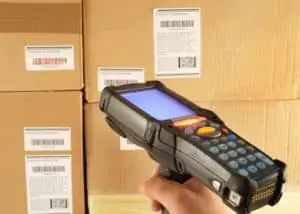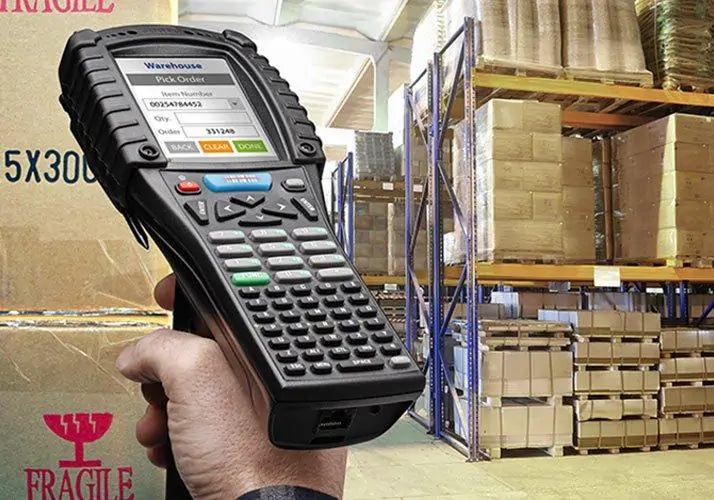 Do you own or operate a business that keeps and stores inventory on-premises? If so, you could benefit from using a handheld inventory scanner to keep track of your inventory.
Do you own or operate a business that keeps and stores inventory on-premises? If so, you could benefit from using a handheld inventory scanner to keep track of your inventory.
These handheld inventory devices are simple to use and dramatically reduce the time involved in manually counting your inventory.
They are incredibly handy for retail stores, restaurants, or any other type of business that must count its inventory on a daily basis.
We are here to provide you with an overview of what a handheld inventory scanner is, what it does, and how you benefit from using one.
We’ll also cover a few of the best options available to you when shopping for your own inventory tracking scanner.
What Is A Handheld Inventory Scanner?

A point of sale system is a network of software and hardware that automate processes and streamline your business processes, freeing up time to focus on more important tasks.
The individual pieces of hardware of a POS system are called peripheral components. These include cash drawers, receipt printers, programmable keyboards, and more.
These components are used to enter and store data around individual sales that a company makes. They also track inventory, which is our topic of the day.
All that data is stored in a central POS system and is later available for reference when measuring and analyzing business metrics.
A handheld inventory scanner is simply another POS hardware component that links into your POS system and serves the purpose of tracking your inventory on a daily basis.
This eliminates the possibility of human error that comes with manually counting your inventory.
How Do Handheld Inventory Devices Work?
Using a handheld inventory scanner is simple and intuitive. Unlike a regular scanner used in the check-out line at most retail stores, it does not just scan barcodes and relay the price back to your cash register.
Instead, it scans the barcode on each item you have in your inventory stock and sends the total number of items of that type that you have in your inventory back to the overall system.
This data is then added to your overall inventory count, stored, and backed up so you can always keep an eye on how much inventory you have and when it’s time to order more of a certain item.
PRO TIP: Discrepancy Reports

A discrepancy report is a report that tells you when the amount of inventory in stock does not match the amount that should be there.
In other words, let’s say you sell widgets. Each time someone rings up a widget with your point of sale cash register, it subtracts one widget from the inventory volume that should be in your stock room.
If you have 100 widgets in stock and have sold 20, you should have 80 left in stock. Let’s say you then use your handheld inventory scanner and count your actual inventory.
You only count 74 widgets in stock. That means you have a discrepancy of 6 widgets and need to investigate where they have gone.
A POS system that produces discrepancy reports will automatically notify you and push out a report alerting you that there is missing stock and that it is time to look into the issue.
So, always be sure that you are able to run discrepancy reports with the handheld inventory scanner that you select. It is one of the major benefits involved in using one in the first place.
Handheld Inventory Scanner Cost & Brands
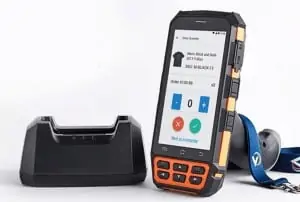
If you want a scanner that doesn’t integrate with your overall POS system but simply counts inventory and lets you send that data to a spreadsheet, you can find one for less than US $100.
On the other hand, if you want a Cadillac-tier scanner that integrates and syncs data back to your POS system, you can pay over US $1,000 for one.
You can get a POS-integrated scanner for less though, to be sure. You may be looking at $300 for a lower-end POS-integrated scanner.
But having a scanner than will integrate into your POS system is critically important to streamlining processes and increasing productivity and revenue growth.
The best bet is to let a POS hardware review site provide you with a personalized recommendation based on your specific and unique needs.
Sites such as POS Quote let you do that. With POS Quote, you simply navigate to the site’s homepage and complete the yellow form for a free quote.
Benefits of Using a Handheld Inventory Scanner
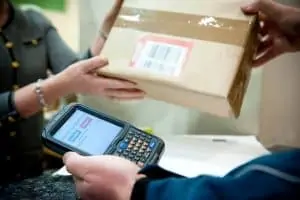
You already know that they help keep track of inventory discrepancies, however, we will elaborate on that benefit below, then touch on additional benefits.
Eliminating Inventory Discrepancies

Discrepancies can occur due to a number of scenarios. For example, if an employee is stealing inventory, you would see an inventory discrepancy appear.
If you suspect that might be the case, you can rely on your security cameras—assuming you use them—to identify what’s going on and remedy it.
Discrepancies can also happen for less-malicious, accidental reasons. If you rely on an employee to manually count your inventory every day, it is almost a certainty that one day someone will miscount your stock.
That’s an innocent mistake. Everyone makes mistakes—it’s part of being human.
But do you know what does not make mistakes while counting? A handheld inventory scanner. That’s why using one provides the great benefit of ensuring accurate inventory counts every time.
Increased Time Savings and Productivity
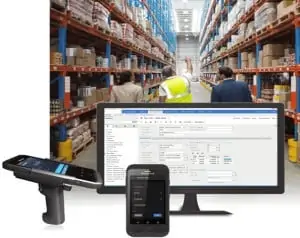
How many times have you been counting something in a hurry, got to 60, then got distracted? You return to counting but now you are not sure if you had just reached 60 or 70. This means you must start over.
All of this wastes time that your employees can spend interacting one-on-one with customers or executing other, higher-value tasks.
It may seem insignificant, but all that wasted time adds up quickly and can have detrimental effects on productivity, the effectiveness of your business, and your overall revenue growth.
Accurate Data Storage

On the other hand, if someone is manually counting your inventory and keeping track with a pen and paper, that data does not automatically appear in your system in real time.
Your employee must manually enter it into a spreadsheet, or, even worse, your paper records if you still keep track of your inventory that way.
Then, what happens if your employee finishes counting inventory manually, then runs to the bathroom and accidentally drops that paper in the sink while the water is running?
Say goodbye to your inventory count and watch your employee return to the storeroom, head hung somberly, to re-count your stock.
Maintaining accurate inventory counts is vital to the health of your business. A handheld inventory scanner streamlines the process but also ensures that your data is accurate every time by removing the potential for human error.
Better and More Accurate Reporting

In order to run accurate sales reports, you must have accurate sales and inventory data. Otherwise, your reporting will be skewed, and you will have a misleading view into how well your business and sales are performing.
Using a handheld inventory scanner—as mentioned above—ensures that the data in your reports is accurate and that the numbers you are looking at are reliable.
With reliable, accurate data you can make better, more informed, data-driven decisions about how to grow your business.
It is important to always maintain an accurate view into how your sales are moving the proverbial revenue needle and using a handheld scanner for inventory purposes ensures your data is accurate and reliable every time.
Portability and Mobility
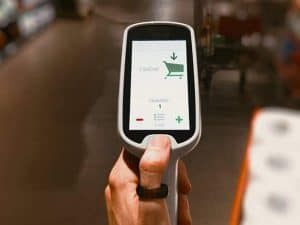
Some retail stores keep inventory in multiple locations throughout the back of their store and employees need to be able to easily take an inventory count in every storage room they have.
The idea of stationary inventory scanners attached to a base with a cord is just not practical in any way. You would need a super long cord for one. And you would also need multiple scanners, one for each respective storeroom.
Then you would have to find a way to connect and sync them all back to your main point of sale system so the data could be stored with the rest of your sales and inventory data.
In short, it would be a nightmare. And that’s why there is no market for stationary inventory scanners, only the handheld type.
Scanning Versatility
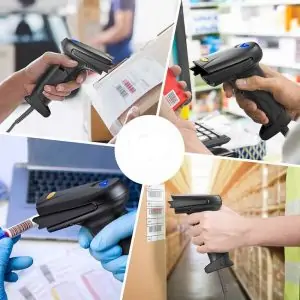
Every item that must be scanned has a code that needs to be scanned in order for it to be recognized by your handheld inventory device.
You are probably thinking, “Great, thanks, Dr. Obvious.” Yes, it’s obvious that a scanner has to scan a code. But which type of codes are you scanning? Have you asked that question?
There are many types of codes on pre-packaged goods these days, and not all scanners can scan all codes.
The traditional scanner that you have probably seen the most is called a one-dimensional (1D) scanner. Then, there is also such a thing as a two-dimensional (2D) scanner.
Both perform a specific function and it is important to know the difference between the two. If you need to scan 2D codes, you need a 2D scanner, and so on.
Below is a quick rundown of these two primary types of scanner.
One-Dimensional Scanners
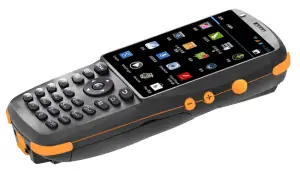
These are a good choice for a simplified business that does not process lots of information and only needs to keep track of basic data.
But, unless you own or operate a very basic store, it is likely that you need a 2D scanner.
Two-Dimensional Scanners
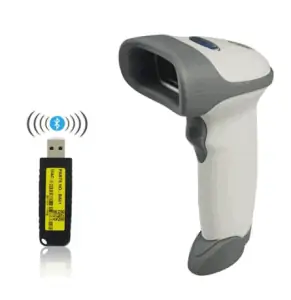
Have you ever seen a store clerk scan a barcode multiple times before it registers in the system? If so, odds are they are using a 1D code scanner. And those 1D scanners are often used to track inventory.
2D scanners allow store employees to more quickly and easily capture the information in a 2D code. They are more reliable in the long run as they can identify bent or damaged 1D barcodes, as well as QR codes for a more comprehensive scanning experience.
They are more expensive than 1D scanners. But, if your business sells products that come with a two-dimensional code, you’ll need a 2D scanner.
Shop for Your Own Handheld Inventory Scanner
Now you have the inside scoop about handheld inventory devices. It’s time to start shopping around.
It’s always advisable to do your own research—which you have, in fact, been doing by reading this article. Well done.
At the same time, as mentioned above, you can and should also take advantage of review sites that offer free recommendations for POS systems and peripheral components.
Best of all, some of these sites can provide you with special discounts when you decide to purchase.
POS Quote, for example, can help you identify the best POS system and inventory scanner for your business—based on your unique business case and needs.
To take advantage of this service, just visit the POS Quote homepage and complete the yellow form. You’ll receive a free quote and up to 30% off on your new POS system—including a handheld inventory scanner.

